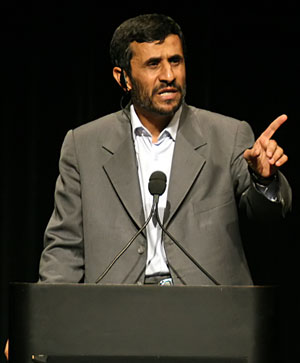
President of Iran, Mahmoud Ahmadinejad.
June 18, 2009
After the dust has settled, Mahmoud Ahmadinejad will again be the president of of the Islamic Republic of Iran. Why and how was he reelected president? Because he was approved once again by Iran’s Guardian Council as a candidate for the nation’s highest office.
The Council consists of six Islamic jurists appointed by the Iran’s Supreme Leader, Ayatollah Seyyed Ali Khamenei, and six from the Majlis, Iran’s popularly elected parliament. They screen presidential candidates through background checks and a detailed written examination. Very few pass the test. Since 2004, the council has routinely rejected reform candidates. If there was fraud in the recent election, it occurred much before the election itself.
Iran is not a democracy; it is a theocracy, an Islamic Republic. Remember, in 1979, Iran’s monarchy under Shah Mohammad Reza Pahlavi was overthrown and replaced with an Islamic Republic under Ayatollah Ruhollah Khomeini (1902-1989), the leader of the revolution. The Islamic Revolution is still ongoing, trying to balance Islamic principles with democratic principles.
As President, Ahmadinejad is not the ruler. He is not the commander-in-chief of the armed forces. He cannot set policies outside the boundaries set by Iran’s Supreme Leader and the Guardian Council, who are not willing to let the Iranian Revolution be overturned.
Why so much media coverage about Iran’s election and, by comparison, so little about the recent elections in Lebanon, India, and El Salvador? Probably because to many in the West, Ahmadinejad is the hateful face of Iran.
Why does Iran consider the U.S. its enemy? Among our crimes are fomenting a military coup that restored Shah Mohammad Reza Pahlavi to the throne and bolstering him with millions of dollars in arms; tilting toward Iraq in the 1980-88 Iran-Iraq war; shooting down a civilian Iran passenger plane in 1988, killing all 290 passengers (the warship’s commander was not punished; he was given the Legion of Merit); favoring Israel in the Israeli-Palestinian conflict; and in 1995 imposing a total embargo on dealings with Iran by U.S. companies, including blocking much needed loans from the World Bank and International Monetary Fund. (While there is an official embargo, trade between the U.S. and Iran did skyrocket in 2008.)
Of course, the U.S. cannot forget the 1979 seizing of the American embassy in Tehran and the holding of Americans hostage followed by the ill-fated attempt to rescue them. Iran is also suspected of complicity in the 1983 bombings of the U.S. embassy in Beirut killing more than 60 people; and later that year, bombing a U.S. military compound killing 241 American servicemen; supporting the Lebanese Shiite militia Hezbollah; aiding “terrorist” activity in the current Iraq war; and finally U.S. concerns about the possibility of Iran developing nuclear weapons.
In the aftermath of Iran’s election, the hope is that the young and middle class supporters of Mir Hossein Mousavi, the losing presidential candidate, will exert pressure on Ahmadinejad and Iran’s theocracy to be less confrontational towards the U.S.
President Obama must continue to seek diplomacy with Iran. After all, this is much more productive than sabre-rattling. Obama’s June 2009, Cairo speech to the Islamic world is an excellent start. But with all the historical baggage between Iran and the U.S., the task will not be an easy one.


 The Hunger Site
The Hunger Site
No Comments
Comments for Iran’s Election and U.S.-Iran Relations are now closed.